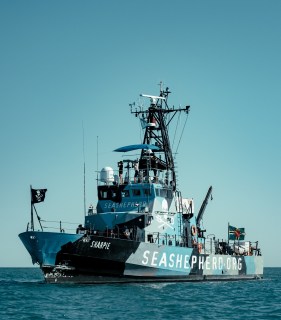Expedition to Sight Critically Endangered Vaquita Porpoise a Success
Published by Sea Shepherd Conservation Society
Leading scientists from Mexico and the USA, supported by Sea Shepherd confirm the first sightings of vaquita in 2019, bringing hope for the species.
San Felipe, BC, Mexico, August 5th, 2019 – A group of scientists and conservationists record the first vaquita sightings of 2019. The visual sighting expedition, a joint effort by Mexico’s National Commission on Protected Areas (CONANP), Sea Shepherd Conservation Society and Museo de la Ballena y Ciencias del mar, is taking place in the Upper Gulf of California, with participation of leading marine mammal researchers from the Autonomous University of Baja California Sur (UABCS) and the USA, as well as support from the Mexican Navy.
Sea Shepherd crew on board the M/V Sharpie had sightings of two pairs of Vaquitas on August 19th and 20th, then two Vaquitas were photographed when sighted on September 3rd. With leading scientists on board, the organizations took advantage of the few days of calm weather to look for the vaquita individuals. Vaquita are the smallest cetaceans on the planet and the most endangered marine mammal on Earth. The species is endemic to Mexico’s Upper Gulf of California. It is estimated there are less than nineteen vaquita alive today.

For the past five years, Sea Shepherd has maintained a maritime presence in the Upper Gulf of California, working with Mexican authorities to protect the rare porpoise. Sea Shepherd removes illegal gillnets from vaquita habitat to protect the mammal from getting ensnared in nets set to catch another endangered species, the totoaba fish.
Totoaba is targeted for its lucrative “buche” or swim bladder, which is trafficked and sold in black markets in Asia. The bladders are consumed in a soup believed to have beneficial health properties, despite lack of scientific evidence confirming such claims. This wildlife trafficking scheme is responsible for the critical situation the vaquitas are facing. Vaquita and totoaba are of a similar size, thus the gillnet mesh used to catch the totoaba are the perfect death trap for the small porpoise.
Despite collaborating with scientists for many years, providing data and supporting acoustic monitoring efforts, this is the first time Sea Shepherd has participated in a visual identification expedition to identify and document vaquita. Sea Shepherd first recorded a vaquita on April 18th, 2015, just two days after Mexico had announced a strong plan of action to protect the vaquita porpoise, bringing the country to the forefront of conservation of endemic species. The 2015 sighting had been the first recording of a vaquita in two years, bringing immediate urgency of the situation to Mexican authorities and paving the way to a long-lasting collaboration between Mexico and Sea Shepherd to protect the species.
The recent collaborative expedition sighted three groups of two vaquitas, between August 19th and September 3rd, in the waters East of San Felipe, Baja California. According to specialists, the vaquitas documented were adult specimens and appeared in good health. “It is excellent to see these vaquitas are well fed, plump and healthy looking, “said conservation biologist and long term vaquita researcher Dr. Barbara Taylor, “this invigorates the resolve for Mexico to protect their species”.

The Research Program for the vaquita is an effort by CONANP and has been a reliable tool to understand the vaquita population for many years. Their acoustic monitoring program is responsible for the most accurate assessments of vaquita trends, therefore a vital tool in efforts to protect the species.
“Following the lead of CONANP and thanks to their tremendous monitoring efforts of the vaquita population, we have been able to find, film and photograph some of the last individuals, “said Eva Hidalgo, Sea Shepherd’s Science Coordinator. “This research work is extremely important to show the world that vaquitas are still alive and strong, so inter-institutional efforts such as the retrieval of illegal gillnets can continue to protect vaquita from extinction,” Hidalgo finished.
The expert vaquita researchers were excited to see the results, “to see vaquitas alive is a relief and shows that we must continue to protect the species,” said Dr. Lorenzo Rojas-Bracho, the head of the Mexican Vaquita Research Program. Captain Locky Maclean, Sea Shepherd’s Director of Marine Operations emphasized the importance of protecting the area where vaquitas remain, by stating, “the zero tolerance area recommended by CIRVA must be completely net free, this is where Sea Shepherd has been focusing patrol efforts and will continue to do so.”

Sea Shepherd has been present in the Vaquita Refuge for the last five years under an agreement of cooperation with the government of Mexico and remains committed to providing its full assistance. Sea Shepherd has deployed multiple vessels from its patrol fleet, monitoring poaching and retrieving 990 pieces of illegal fishing gear, including approximately 200 kilometers of illegal gear – all from vaquita habitat. Sea Shepherd’s vessel, the M/V Sharpie is currently inside the vaquita habitat performing this important collaborative visual spotting expedition to gather data and visual identification of the last vaquita porpoises.
“It is very important to document these live vaquitas,” said Sea Shepherd founder and CEO Captain Paul Watson. “Our crews have been working tirelessly, day and night, to remove the gillnet threat from the vaquita’s path. Some say the plight of the vaquita is a lost cause, but we believe that lost causes are the only causes worth fighting for and all our crew are united in this belief that the impossible can become possible. And it is the passion, courage, imagination and resourcefulness of my incredible crew that will win this fight for the vaquitas and for the oceans.”
Sea Shepherd’s illegal gillnet removal program, Operation Milagro, will resume in early October, working with Mexican authorities as fishing season begins in the Upper Gulf of California.








Read the full article at: https://seashepherd.org/2019/09/09/expedition-to-sight-critically-endangered-vaquita-porpoise-a-success/?utm_source=rss&utm_medium=rss&utm_campaign=expedition-to-sight-critically-endangered-vaquita-porpoise-a-success



